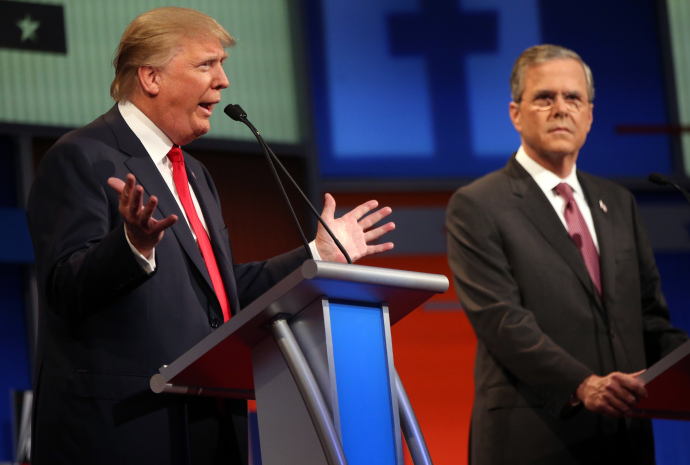Modern politics treats “Republicans” as interchangeable with “conservatives.” The conflation occurs from local levels to the national stage, such as when Jeb Bush declared that he will cut taxes and “apply conservative principles the right way [and], create an environment where everybody rises up.” While conservatism includes aspects of limited government intervention such as cutting taxes, the term expands beyond the Republican platform itself. Given that 72—not 100—percent of Republicans identify as “conservative” as a whole, we cannot ignore heterogeneity within the Republican party.
Surveying the Field
Libertarian conservatives stick to the ideology that any and all government intervention in the economy should cease, while social conservatives dictate that the government should only interfere in social issues, such as abortion and same-sex marriage. Pro-business conservatives desire pro-corporate government intervention, and neoconservatives believe that the only government intervention should be in financing a foreign policy that promotes democracy and American interests abroad. What is most perilous about these factions is that they all reside within one party that attempts to unite around one platform. Without a unified base that believes in one unified form of conservatism, a cohesive voting block is near impossible. Such an issue has been on the rise for a while, and the confusion about where the GOP as a whole stands on an issue plagues even those who identify with the party.
With the fracturing of the GOP in mind, the scattered positions of the 13 candidates make ideological sense. These 13 candidates each appeal to a different combination of conservative factions.
Carly Fiorina’s statement on sending a “very clear message” to Russia’s President Putin indicates she attempts to appeal to neoconservatives, and her platform for eliminating estate tax aligns with pro-business conservatism. Yet Fiorina’s campaign blatantly contradicts libertarian conservative theory in her desire to interfere in the economy to benefit businesses; in essence, she isolates this faction.
Jeb Bush also supports a neoconservative economic policy. His policies to restrict affirmative action while he was Florida state governor combined with his opposition of using federal funds for the Common Core place identify him as a partial social conservative. Like Fiorina, he also, though, the former Florida governor approves of the neoconservative ideals, wanting to increase defense spending.
Bush and Fiorina attempt to cover all factions of conservatism, but still manage to split their party further in their exclusion of some factions. Their split platforms match the split of the party, seen in a Gallup poll that demonstrated that only 56 percent of the GOP wants to increase defense spending. In other words, only 56 percent of the base is neoconservative.
In contrast, Senator Ted Cruz’s (R-Tx.) campaign could be construed as libertarian conservative on economics. From his track record of mostly attempting to sue the government, repealing legislation, and removing “federal impediments”, Cruz has attempted to end government intervention rather than legislate to improve businesses. His path diverges from Fiorina in economics, demonstrating a split that will occur with voters when it comes to the economy.
Sen. Rand Paul (R-Ky.) also has a libertarian economic point of view—no government intervention, period. In his online campaign platform he states, “I will work to balance our budget and only spend what comes in. We must cut spending in all areas, particularly areas that are better run by state and local governments”. Like Cruz’s, Rand Paul’s policy on economics will split libertarian conservatives and pro-business conservatives. While pro-business conservatives will like lower taxes, they conflict with libertarian conservatives in their desire to have government intervention and increased spending only in the case of supporting businesses. Paul’s suggested cuts exclude the pro-business community from receiving government intervention and active support.
A Fragmented Party
As a whole, the election stands as a great platform for seeing Republican fragmentation. Divisions appear not only in the platforms of candidates, but also in debates and interviews candidates. In a FiveThirtyEight report ranking conservatives based on voting record, public issue statements, and fundraising, the candidates rank from a low of 13 to a high of 60, on a scale with 100 being the most conservative. Evidently, the rankings from FiveThirtyEight accurately reflect the diversity in the electorate.
In the first Republican debate, Cruz addressed the different kinds of conservatism, but completely missed the point when he declared, “We see lots of ‘campaign conservatives.’ But if we’re going to win in 2016, we need a consistent conservative, someone who has been a fiscal conservative, a social conservative, a national security conservative.” While Cruz recognized the different types of conservatism, he fell into the trap of associating “conservative” with “Republican.”
On a larger scale, Cruz fails to understand that “consistent conservative” is an oxymoron, as elements of conservatism contradict. Herein lies the problem of the campaign. Candidates such as Cruz attempt to appeal to the interests of different types of conservatism, creating a base of contradictory policy. Moreover, in calling to all forms of conservatism, candidates split up the party even more as different policies compete for attention.
If the candidates do not understand the context and depth of fragmentation within their party, there is little hope for unity. Until the party discovers a way to dismantle the culture of conservatism and create a platform that accurately represents their base, fragmentation is likely to continue. As Professors Gary Miller and Norman Scofield from Washington University in Saint Louis argue in a qualitative study of candidates’ positions, “activist coalitions must be aware that fragmentation creates losers.”
The GOP needs to adapt, adjusting their party platform to handle pluralism and accommodate more views. This includes incorporating different types of conservatism in their agenda and balancing the types of conservatism to prevent contradictions. However, none of this party reformation can occur unless the GOP accepts that their party is fragmented and realizes that their “conservatism” is a lot broader than they think.
Image Source: Flickr / Peter Stevens
